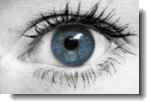
So if you can tint a contact lens in order to help the patient find it, why not add tint to actually change the patient's eye color? Well, they did just that for soft contacts (hard or rigid contacts aren't big enough for the effect to work properly) in 1984. A process for tinting soft contacts was invented that could change the color of light blue or green eyes only. Colored contacts were only mildly popular until 1986, when Wesley-Jenssen, Inc from Chicago introducted lenses that could change brown eyes to blue, aquamarine, or green. It was at this point that the contact lense industry started booming again.

For years, hard and rigid gas permeable contact lenses have actually been slightly tinted. This is not for looks, it just helps a patient find a contact lense easier if he/she happens to drop it. The tint is so light, that it is not visible when the lense is worn by the user.
Some wear these lenses not to correct their vision, but purely for cosmetic reasons. There is nothing wrong with this, but remember: the risk of infection with colored contact lenses is just as great as with regular lenses. Take the time to properly disinfect them, and try not to wear them for more than 24 hours at a time.

Also See:
Contact Lenses | Glaucoma | Just For Fun | Eyeglasses | Eye Doctor | Eye Care And Symptoms | Eye Anatomy | Online Eye Tests | Laser Eye Surgery | Laser Eye Surgery Directory: Canada | Laser Eye Surgery Directory: USA | Laser Eye Surgery Reviews | Submit A Review | Contact Us | Privacy Policy | Sitemap
Copyright 2006-2009 Vision Health
Contact Lenses: Tinted & Colored

